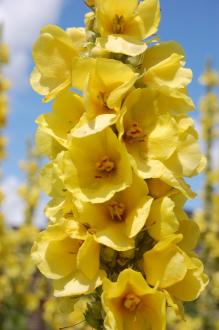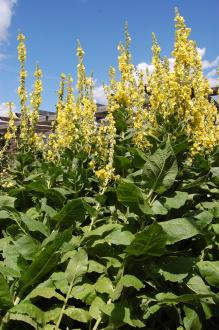
Verbascum phlomoides Flower (30/06/2012, Kew Gardens, London)
Position: Full sun
Flowering period: Summer to early autumn
Soil: Moist, well drained
Eventual Height: 1.2m
Eventual Spread: 60cm
Hardiness: 6a – 9a
Family: Scrophulariaceae
Verbascum phlomoides is an erect biennial herbaceous perennial. Its mid green leaves form a basal rosette in its first year. In its second year of growth its leaves are alternate, acuminate with dentate margins. Its yellow flowers have five petals, are up to 3cm across and appear in dense spike like clusters.Its flowers are self fertile.
Verbascum phlomoides, commonly known as Orange Mullein, Wooly Mullein or Clasping Mullein, is native to central and southern Europe and south west Asia. It has been cultivated in the UK since 1739 and has now naturalised, particularly in the south.

Verbascum phlomoides (30/06/2012, Kew Gardens, London)
The etymological root of the binomial name Verbascum is derived from a corrupted form of Barbascum, the ancient Latin name for this genus of plant. Phlomoides is derived from the Latin meaning ‘like Phlomis’.
The landscape architect may find Verbascum phlomoides useful as part of a prairie type planting scheme.
Ecologically, V. phlomoides is attractive to pollinating insects.
V. phlomoides prefers moist, fertile, well-drained soils. It tolerates most pH of soil. It will tolerate very alkaline soils. It will not tolerate waterlogged soils.
Verbascum phlomoides requires little maintenance.

